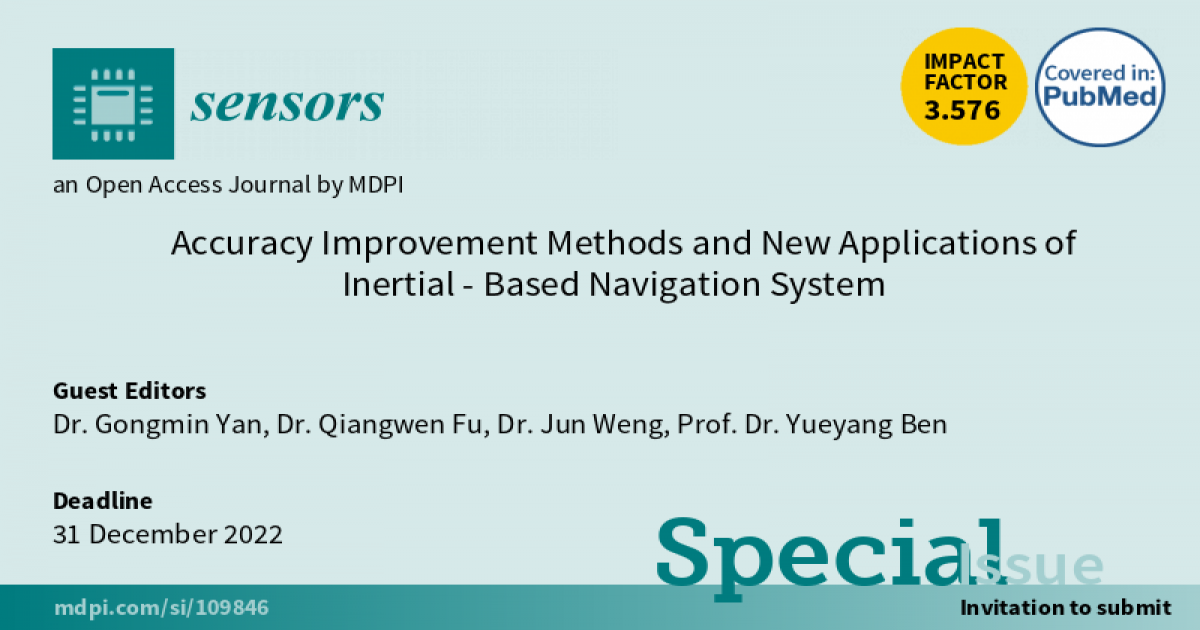Accuracy Improvement Methods and New Applications of Inertial-Based Navigation System
A special issue of Sensors (ISSN 1424-8220). This special issue belongs to the section "Navigation and Positioning".
Deadline for manuscript submissions: closed (31 December 2022) | Viewed by 34429

Special Issue Editors
Interests: error modeling and testing of inertial devices and calibration of strapdown inertial navigation system; transfer alignment technology of inertial navigation system and initial alignment technology of moving base; inertial based vehicle autonomous positioning and orientation technology; theory and application of high precision integrated navigation and information fusion; autonomous driving technology; robot autonomous navigation technology
Special Issues, Collections and Topics in MDPI journals
Interests: error modeling of optical gyroscope; autopilot of vehicle
Interests: robotic navigation; intelligent fault detection
Interests: high-accuracy updating algorithm of SINS; visual navigation; integrated navigation
Special Issues, Collections and Topics in MDPI journals
Special Issue Information
Dear Colleagues,
Inertial measurement, which has been widely applied in aerospace, aviation, automatic pilot, AUV, and many other fields, is a key technology for motion detection and control for most vehicles. The inertial navigation system with multi-source information fusion has become a mainstream solution to the problem that the navigation errors of the pure inertial navigation system essentially increase over time. A stable inertial-based navigation system to provide more accurate navigation information is urgently required for smart city construction, precision agriculture, precision-guided munition, etc., in future. Hence, improving the measurement accuracy and measurement reliability of attitude, velocity, and position has always been a hot topic in the field of inertial-based navigation system research.
The scope of this Special Issue will be the principle and performance improvement of inertial sensors, design methods of high-accuracy navigation, the technology of multi-sensor information fusion, and new applications of inertial-based navigation systems. The topics of interest include, but are not limited to, the following:
- Novel principles of inertial sensors;
- Accuracy improvement approach and technology of inertial sensors;
- Modeling and compensating technology of inertial sensor errors;
- Accurate testing and calibration of the inertial navigation system;
- Accurate alignment of the inertial-based navigation system on the moving base;
- High-accuracy updating algorithms for inertial navigation systems;
- Novel filtering methods of multi-sensor integrated navigation (GNSS/DOV/visual navigation/LiDAR/map matching);
- Intelligent fault detection approach for navigation systems;
- New applications of inertial-based navigation systems in new fields (autopilot/energy and resource extraction/smart farming and precision agriculture).
Dr. Gongmin Yan
Dr. Qiangwen Fu
Dr. Jun Weng
Prof. Dr. Yueyang Ben
Guest Editors
Manuscript Submission Information
Manuscripts should be submitted online at www.mdpi.com by registering and logging in to this website. Once you are registered, click here to go to the submission form. Manuscripts can be submitted until the deadline. All submissions that pass pre-check are peer-reviewed. Accepted papers will be published continuously in the journal (as soon as accepted) and will be listed together on the special issue website. Research articles, review articles as well as short communications are invited. For planned papers, a title and short abstract (about 100 words) can be sent to the Editorial Office for announcement on this website.
Submitted manuscripts should not have been published previously, nor be under consideration for publication elsewhere (except conference proceedings papers). All manuscripts are thoroughly refereed through a single-blind peer-review process. A guide for authors and other relevant information for submission of manuscripts is available on the Instructions for Authors page. Sensors is an international peer-reviewed open access semimonthly journal published by MDPI.
Please visit the Instructions for Authors page before submitting a manuscript. The Article Processing Charge (APC) for publication in this open access journal is 2600 CHF (Swiss Francs). Submitted papers should be well formatted and use good English. Authors may use MDPI's English editing service prior to publication or during author revisions.
Keywords
- inertial navigation
- error modeling
- error calibration and compensation
- initial alignment on moving base
- multi-sensor information fusion
- intelligent fault detection
Benefits of Publishing in a Special Issue
- Ease of navigation: Grouping papers by topic helps scholars navigate broad scope journals more efficiently.
- Greater discoverability: Special Issues support the reach and impact of scientific research. Articles in Special Issues are more discoverable and cited more frequently.
- Expansion of research network: Special Issues facilitate connections among authors, fostering scientific collaborations.
- External promotion: Articles in Special Issues are often promoted through the journal's social media, increasing their visibility.
- Reprint: MDPI Books provides the opportunity to republish successful Special Issues in book format, both online and in print.
Further information on MDPI's Special Issue policies can be found here.









